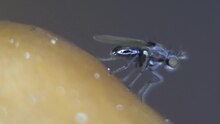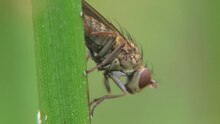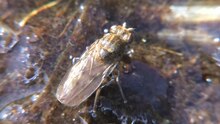Salt flies
| Salt flies | ||||||||||||
|---|---|---|---|---|---|---|---|---|---|---|---|---|

Hydrellia griseola |
||||||||||||
| Systematics | ||||||||||||
|
||||||||||||
| Scientific name | ||||||||||||
| Ephydridae | ||||||||||||
| Zetterstedt , 1837 | ||||||||||||
| Subfamilies | ||||||||||||

The salt or swamp flies (Ephydridae) are a family of the two-winged flies ( Diptera) and are assigned to the suborder Muscomorpha within the flies (Brachycera) . Salt flies are common around the world, around 2000 species were described up to February 2014, of which around 340 occur in Europe.
features
Adult fly
Most of the species in the family reach a length of 1 to 11 millimeters, remain small to very small and have a compact habit with mostly dark, matt to glossy basic color. The wings of some species ( e.g. from the genus Hydrelia ) are transparent, while others have a dark basic color, sometimes with a light pattern ( e.g. Padyra , Scatella ). The veining of the wing is reduced: the discoidal cell is fused with the posterior basal cell, no subapical cells are formed and anal cells are also absent. The costa is clearly interrupted twice. The face is strongly arched forward, the forehead is noticeably bristled and the mouth is noticeably large. The antennae consist of three segments with either completely hairless or feather-like bristles on the underside.
larva
The larvae are adapted in different ways to their environment and their specific nutritional basis. Many species develop in the water, others live in moist substrate or as leaf miners . Within a species, the three larval stages do not show any great morphological differences, but in the last stage the thorny body structures are often reduced. The cylindrical body tapers towards the front and ends in the rounded head. At the back of many species it has an at least partially extendable breathing tube. The basic color of the larvae is usually white, light gray or cream-colored, often with dark parts of the body.
Doll
The larva pupates in the last larval skin (puparium) without changing its external shape. Their coloring changes to a light or darker shade of brown. The systems of the legs and wings are not fused with the body surface within the puparium (free pupa).
Way of life
Habitats
Flies from this family inhabit a wide variety of habitats, including many habitats that require remarkable physiological adjustments in larval stages. Most species live near fresh water, for example in wet meadows or on the banks of ponds, ponds, lakes and rivers. Wirth was able to demonstrate in North American species from the genus Ephydra that colonization of more extreme locations such as saline and alkaline wetlands took place from here. Other species inhabit the hot springs of North America, Iceland, Japan, New Zealand, and Europe. The larvae of Helaeomyia petrolei develop in the natural oil ponds of California and Cuba. Many species are also found in near-ocean, salty habitats such as coastal fringes, mangrove swamps, and tidal pools.
nutrition
The larvae of most species feed on small organic particles such as bacteria, algae, and detritus. Others live on carrion or as leaf miners on plant tissue ( Clanoneurum , Hydrellia , Psliopora ). Species from the genus Ochthera have developed a predatory way of life and eat mosquito larvae . The larvae of Trimerina madizans parasitize on spider egg cocoons in wetlands in Europe. The adult flies of most species are microphagous, they feed on microorganisms such as algae and bacteria; Flies from some genera also eat dead insects or look for nectar sources, whereas Ochthera species are active hunters who also prey on other species of salt flies.
Reproduction
For some species of salt flies, special behaviors have been described that precede the actual mating. For example, Scatella stagnalis has a distinctive mating ritual. In many other species, however, this is completely absent. After mating, the females lay their usually 170 to 600 eggs individually or in groups on plants or in moist, mineral substrate over a period of 7 to 10 days. The elongated oval eggs are usually white, pale pink or brown to black in color and 0.3 to 1.4 millimeters long and about 0.5 to 1.0 millimeters wide. Presumably for camouflage, the females from some genera ( Hyadina , Coenia , Parydra ) cover their clutch with feces.
Systematics
|
|||||||||||||||||||||||||||||||||||||||
| Systematic position of salt flies within the superfamily Ephydroidea (after Wiegmann et al., 2014) |
The salt flies are now generally assigned to the superfamily Ephydroidea due to morphological similarities with some other families . This monophyletic line of development is generally considered to be well documented today, even if the position of individual families within this group has not been conclusively clarified. The salt flies are viewed as a separate taxon , which was split off from the rest of the superfamily at an early stage in their phylogeny .
First early attempts at a systematic sighting of salt flies by Loew and Becker led to the description of three subfamilies (Ephydrinae, Notiphilinae, Hydrelliinae). Later Cresson assigned the genera and clans to four subfamilies (Psilopinae, Hydrelliinae (formerly Notiphilinae), Parydrinae, Ephydrinae). In 1992 Zatwarnicki then proposed, based on phylogenetic analyzes, a division into the five subfamilies Discomyzinae, Hydrelliinae, Gymnomyzinae, Ilytheinae and Ephydrinae; this is widely recognized today.
Economical meaning
Species of the genus Hydrellia , especially Hydrellia griseola , can cause losses in rice production due to their mining larvae. In the same way, Psilopa leucostoma can damage the leaves of sugar beet. Scatella stagnalis is a carrier of a Pythium root fungus in cucumbers in hydroponics. In some studies the possibilities of using salt flies against weeds on wetland as well as against immigrating aquatic plants were examined.
Types (selection)
Individual evidence
- ↑ T. Zatwarnicki, J. Kahanpää: Checklist of the family Ephydridae of Finland (Insecta, Diptera). In: ZooKeys. (441), 2014, pp. 339-346. (on-line)
- ↑ T. Zatwarnicki: Family Ephydridae (Animalia: Eumetazoa: Arthropoda: Hexapoda: Insecta: Diptera: Brachycera). In: T. Pape, P. Beuk (Eds.): Https://fauna-eu.org/cdm_dataportal/taxon/1f210ee4-c9dd-4f54-bbfa-0c5ac0439cdb Fauna Europaea: Diptera, version 2.6.2., 2013.
- ^ P. Oosterbroek: The European Families of the Diptera: identification, diagnosis, biology. KNNV, Utrecht 2006, ISBN 90-5011-245-5 .
- ^ L. Watson, MJ Dallwitz: British insects: the families of Diptera. Version: January 1st, 2012. (online)
- ↑ J. Haupt, H. Haupt: flies and mosquitoes. Observation - way of life. Weltbild, Augsburg 1998, ISBN 3-89440-278-4 .
- ↑ a b c H. Visser, HH Veldhuijzen van Zanten: European Limnofauna> Species: Family Ephydridae (Shore-flies; brine-flies). (wbd.etibioinformatics.nl) ( Memento of the original from March 4, 2016 in the Internet Archive ) Info: The archive link was inserted automatically and has not yet been checked. Please check the original and archive link according to the instructions and then remove this notice.
- ^ WW Wirth: The brine flies of the genus Ephydra in North America (Diptera: Ephydridae). In: Ann. Entomol. Soc. At the. 64, 1971, pp. 357-377.
- ↑ WW Wirth, WN Mathis: A review of the Ephydridae living in thermal springs. In: N. Am. Benthol. Soc. 1979, pp. 21-45.
- ^ GH Schwabe: Contributions to the knowledge of Icelandic thermal biots. In: Arch. Hydrobiol. 6 (SuppJ. B), 1936, pp. 161-352.
- ^ SL Tuxen: The hot springs of Iceland. Their animal communities and their zoogeographical significance. In: The Zoology of Iceland. 1 (11), Einar Munksgaard, Copenhagen 1944, pp. 1-206.
- ↑ SF Sakagmi: About Scatella calida Matsumura, a Japanese fly species (Diptera, Ephydridae) that lives in hot springs. In: J. Fac. Sci. Hokkaido Univ. Ser. VI. Zool. 14, 1960, pp. 293-298.
- ^ MJ Winterbourn: The distribution of algae and insects in hot spring thermal gradients at Waimangu, New Zealand. In: NZJ Mar. Freshwater Res. 3, 1969, pp. 459-465.
- ↑ M. Ciofalo: Fauna Siciliana termale. In: Rend. Mem. R. Acad. Sci. Let. Art. Zelanti Acircale. 4, 1927, pp. 49-76.
- ^ A b BA Foote: Biology of Shore Flies. In: Annu. Rev. Entornol. 40, 1995, pp. 417-442.
- ↑ BA Foote: Biology of Trimerina madizans, a predator of spider eggs (Diptera: Ephydridae). In: Proc. Entomol. Soc. Wash. 86 (3), 1984, pp. 486-492.
- ↑ I. Ceianu: Contribution to knowledge of shore flies (Diptera: Ephydridae) in Romania. In: Entomol. rom. 3, 1999, pp. 125-136.
- ↑ a b DL Deonier: Observations on mating, oviposition, and food habits of certain shore flies (Diptera: Ephydridae). In: Ohio J. Sci. 72 (1), 1972, pp. 22-29.
- ↑ a b BM Wiegmann et al: Episodic radiations in the fly tree of life. In: National Academy of Sciences. Proceedings. Vol. 108, 2011, pp. 5690-5695. (online) ( Memento of the original from September 24, 2015 in the Internet Archive ) Info: The archive link has been inserted automatically and has not yet been checked. Please check the original and archive link according to the instructions and then remove this notice.
- ↑ J. Kahanpääi: Checklist of the Braulidae, Camillidae, Diastatidae and Drosophilidae of Finland (Diptera, Ephydroidea). In: ZooKeys. 441, 2014, pp. 333-338, doi: 10.3897 / zookeys.441.7057
- ↑ H. Loew: New contributions to the knowledge of the Diptera. Seventh contribution. The European Ephydrinidae and the species of the same observed so far in Silesia. Progr. K. Realschule Meseritz 1860, 1860, pp. 1-46.
- ↑ T. Becker: Dipterological studies. IV. Ephydridae. In: Berl. Ent. Z. 41, 1896, pp. 91-276.
- ↑ T. Becker in: E. Lindner (Ed.): The flies of the Palearctic region. 6 (1), 1926, pp. 1-115.
- ^ ET Cresson Jr .: Synopsis of North American Ephydrinae (Diptera). In: Trans. Am. entomol. Soc. 68, 1942, pp. 101-128; 70, 1944, pp. 159-180; 72, 1946, pp. 227-240; 74, 1948, pp. 225-260.
- ↑ T. Zatwarnicki: A new classification of Ephydridae based on phylogenetic reconstruction (Diptera: Cyclorrhapha). In: Genus. 3, 1992, p. 65119.
Web links
- Picture gallery at Diptera.info




